Unit 13
The Passion Week Begins
Unit 13
The Passion Week Begins
Unit 13
The Passion Week Begins
Chapter 01
Preview Of Events And The Triumphal Entry
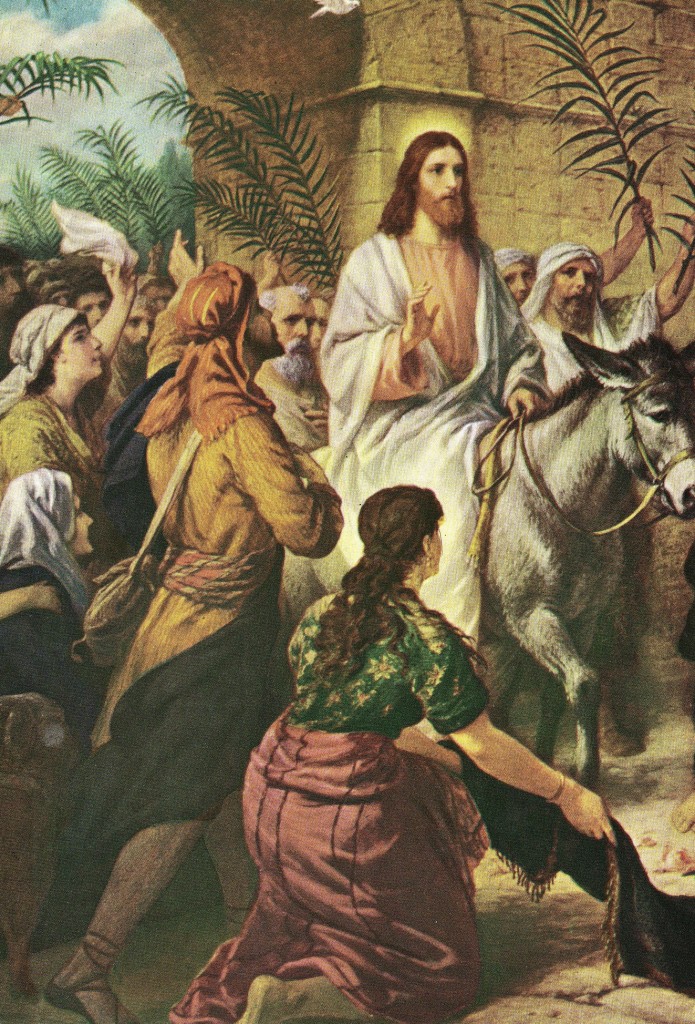
13.01.00.A. THE TRIUMPHAL ENTRY. Artwork by Heinrich Hoffmann. Jesus enters Jerusalem as the crowds wave palm branches. The waving of branches before a monarch was an ancient “body language” whereby people expressed their acceptance and allegiance to their king. The entry was the most significant public proclamation by Jesus that He was the Messiah, a direct fulfillment of “the day” of Psalm 118. To this announcement the religious establishment responded by planning His death.
13.01.01 Introduction and Summary of the Passion Week[1] Events
The most important week in the history of humanity has become known as the Passion Week beginning when Jesus entered Jerusalem. The immense popularity He had in the city can be clearly seen in sharp contrast to the immense hatred of His enemies when they stood before Pilate.
Tensions always ran high at Passover because it was believed that was the most likely time for the messiah to rise and begin another revolt for national freedom. Therefore, extra soldiers were present to crush any self-proclaimed messiahs, as well as the expected rebellion that would follow. At Qumran, the Essenes wrote of an expected messiah and various false prophets also wrote of one in Pseudepigrapha literature.[2] These all reflect the various expected dreams and opinions of the time.
Since the Roman occupation began, several individuals claimed to be the messiah but were consequently killed or crucified.[3] For this reason, Herod the Great upgraded the Hasmonean Baris and renamed it as the Antonio Fortress. It was adjacent to the temple, and he stationed extra military units inside the temple at every Passover. He wanted to be sure that if a messianic pretender did announce himself, his soldiers would put a quick end to his life as was done to the little boys in Bethlehem.
However, the Old Testament prophets described a messiah who was to be very different from the many first century expectations. It is interesting that there seems to be little or no evidence that the rabbis of this era were reviewing “Daniel’s 70 weeks,” and if they pondered the possibilities that the predicted 490 year period might end soon and the Messiah would appear. If they did, in fact, suspect Jesus to be the Messiah, then they should have suspected that rejection of Him would bring destruction to the city and nation – the judgments that are described in Deuteronomy 28.
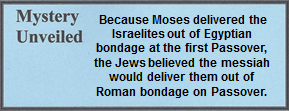
Into this political caldron entered Jesus, riding on a donkey, a humble resemblance to a king on parade entering one of his cities. The people loved Him. His reputation for healing and excellent teaching went far beyond Israel! He never spoke a harsh word to anyone, except of course, to those hypocritical religious leaders who did not practice what they preached. As long as He was moving in the villages and among the synagogues, He was in Pharasaic territory and the Sadducees were enjoying the frustrations of their enemies – the Pharisees. However, when Jesus cleansed the temple, He deliberately entered Sadducean territory. Consequently, He galvanized all of His enemies against Him.
As Jesus exposed the corruption of the religious elite, they began to plot their strategy. Their dirty work would have to be done at night when those who loved Him would be sleeping. Furthermore, if they could not get Him executed for religious reasons, then they would attempt a political accusation, such as accusing Him of being a messiah with anti-Roman political ambitions.
At this point, it is important to provide an overview of the many events that transpired in the last week. There have been various attempts to calculate which year the Passion Week occurred. Suggested years range from A.D. 26 to A.D. 36. The latter has been often chosen because Jesus started His ministry when He was about 30 years of age (Lk. 3:23).[4] In the sixth century it was assumed that Jesus was born in year 1 and had a three and a half year ministry period. This obviously adds up to the year 33. However, as previously explained, He was born between the years 7 and 5 B.C.[5] Furthermore, the term “about 30” years of age permits Him to have begun His ministry when He was a little older. Assuming a three and a half or possibly a four and a half year ministry period, the years add up to the year A.D. 30 with no difficulty. This is confirmed by Jewish writings that state a number of strange events occurred about four decades before the temple was destroyed, meaning, these occurred in the year A.D. 30. In calculating years, it must be remembered that there is no year zero, the time from December 31, 1 BC to January 1 AD 1, is one day, not one year.
The Triumphal Entry was the fulfillment of three significant prophecies.
The second half of Daniel 9:26 states that after the Anointed One is cut off, the ruler of the people will come and destroy the city and sanctuary.[8] That ruler was the Roman General Titus and his Tenth Legion, as they not only destroyed the city, but also destroyed and dismantled the temple and thousands were slaughtered in the process. This clearly points to Jesus as being the Anointed One.[9] Furthermore, just prior to the Roman entry of the temple, the Zealots entered and destroyed all financial records that pertained to debts, and when the Romans came, they destroyed the genealogical books. So no one after A.D. 70 could prove that he was a descendant of King David.
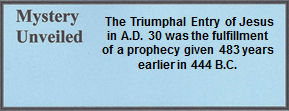
Jesus was the fulfillment of the sacrificial Lamb of God. Moses said in Exodus 12:3 that on the 10th day of the first month of Nissan acquire a lamb and bring it into their homes. There they would observe it for any imperfections as it was not to have a proverbial “spot or blemish.” Of course during that time everyone, especially children, became affectionately close to the cute little thing. But then, four days later, the lamb was sacrificed.
This is the day the Lord has made;
let us rejoice and be glad in it.
The obvious question is, “what day?” It was the anticipated day that the messiah would ride into Jerusalem. It finally arrived. The next verse (25a) reads, “Lord, save us!” which is precisely why the people shouted “Hosanna” (Lk. 19:42). The term “hosanna” (Gk. hosanna 5614) is generally understood as a prayer of praise meaning Lord, save us or save us now,[10] but in the first century it also meant please deliver us.[11] The crowds knew that they were shouting a reference to the psalm when they addressed this phrase to Jesus – for they wanted Him to be their king; their messiah. Unfortunately, national Israel would reject Him, which is why He later said in Luke 19:42 that if they “knew this day” it would bring them peace – the phrase is a reference to Psalm 118:24.

As Jesus approached the city gates, the public praises became increasingly intense. It was only a few days since Lazarus was raised from the tomb and the news of this incredible event spread like wildfire. Everyone remembered His many miracles and now they wanted to make Him their king. People probably thought that since Jesus performed such great wonders, He could conquer the Romans, clear the temple of its corrupt priesthood, re-establish the long awaited Davidic Kingdom and the Davidic Covenant.[12] In the meantime, as the crowds praised the Miracle Worker, Caiaphas and his Roman friends were nervously waiting for what would happen next. At this point Jesus probably remembered Satan’s temptation of kingship after His baptism.
The life of Jesus was filled with numerous prophetic fulfillments. Yet there is one that would not be recognized for another four decades. It is a prophetic word given by the prophet Daniel while in Babylon.[13]
After those 62 weeks the Messiah will be cut off and will have nothing. The people of the coming prince will destroy the city and the sanctuary.
Daniel 9:26a
Only after the temple was destroyed in A.D. 70, did Jewish and Gentile believers realize the significance of Daniel’s prophecy. The destruction confirmed that Jesus was the expected messiah, because according to Daniel, He would come before the temple’s destruction.
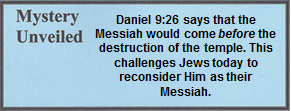
Jesus had spent His ministry years teaching about the Kingdom of God; that to know God was to know Him – Jesus. His Triumphal Entry (Mt. 21:4-5) was the fulfillment of Zechariah 9:9-10, but more than that, it was also the public presentation of Himself to national Israel as their Messiah. He had spent several years in ministry and while He had a great following of common peasants, this was the last opportunity for the Jewish leadership, commonly referred to as “national Israel,” to accept or reject Him. Since the Jewish leadership officially rejected Him and His message, He announced the official end of Israel’s stewardship of the Kingdom of God (Mt. 21:33-43). Instead, His gospel would now be preached to all nations (Mt. 26:13) by Gentiles and one day the entire world will be judged (Mt. 25:31-46). This new kingdom is the new covenant, symbolically sealed with His blood for all Jews and Gentiles who would accept Him as their Messiah (Mt. 26:26-28).
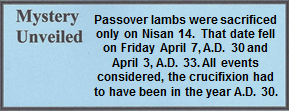
In summary, the Triumphal Entry of Jesus announced, without question, the fact that the Jewish people accepted Jesus as their messiah – although they were thinking of Him as a political-messiah.
There can be no question that the popularity of Jesus had reached its climax. In John 6:14-15 the people tried to make Him king and now they greeted Him as king.
[1]. The phrase Passion Week is an old English term that means Suffering Week.
[2]. See “Barabbas” in Appendix 26.
[3]. Simon bar Kokhba was one of those who claimed to be the Messiah who would deliver the Jews from the Romans. He led an uprising in A.D. 132 which resulted in the utter destruction of Jerusalem three years later. Both Jews and Christians were expelled from the city and the victorious Roman general Hadrian renamed Israel, “Palestinia,” in honor of the ancient Philistine enemies. From this name that the modern name “Palestine” is derived. See also Appendix 25.
[4]. Maier, In the Fullness of Time. 345.
[5]. See 04.03.10.Q3 “When was Jesus born?”
[6]. While this writer agrees with F.F. Bruce (New Testament History, 192 n2) and Arnold Fruchtenbaum, (The Jewish Foundation of the Life of Messiah: Instructor’s Manual. Class 20, page 19.) that the year A.D. 30 is the crucifixion date, a majority view appears to lean toward the A.D. 33 date. One of the earliest studies of the crucifixion date was by Sir Robert Anderson (1841-1918) and is titled The Coming Prince. It was first published in Great Britain in 1894 and quickly became a classic, but it has some problems. In 1978 Dr. Harold Hoehner, in his book Chronological Aspects of the Life of Christ, resolved four difficulties of Anderson’s work. Hoehner presents strong arguments defending an A.D.33 crucifixion date. See Pentecost, The Words and Works of Jesus Christ, 572. See also Appendix 19.
[7]. See 16.01.18.Q5. “What was the year of His death?” for more details.
[8]. See Appendix 15 concerning Daniel’s prophecy.
[9]. Metzger, God in Eclipse. 151-52.
[10]. Bookman, When God Wore Sandals. CD Trac 12; Lang, Know the Words of Jesus. 334-35; Vine, “Hosanna.” Vine’s Complete Expository Dictionary. 2:312.
[11]. Fischer, The Gospels in Their Jewish Context. (Lecture on CD/MP3). Week 7, Session 1.
[12]. For a study of Jewish covenants from a messianic Jewish perspective, see Arnold Fruchtenbaum, Israelology: The Missing Link in Systematic Theology.
[13]. See Appendix 15 concerning Daniel’s prophecy.
[14]. Fischer, The Gospels in Their Jewish Context. (Lecture on CD/MP3). Week 7, Session 1.
13.01.02 Lk. 19:29-31; Mt. 21:4-7; Mk. 11:4-7 (See also Jn. 12:14-16) Bethpage and Bethany
JESUS SENDS FOR COLT
Lk. 29 As He approached Bethpage and Bethany, at the place called the Mount of Olives, He sent two of the disciples 30 and said, “Go into the village ahead of you. As you enter it, you will find a young donkey tied there, on which no one has ever sat. Untie it and bring it here. 31 If anyone asks you, ‘Why are you untying it?’ say this: ‘The Lord needs it.’ ”
Mt. 4 This took place so that what was spoken through the prophet might be fulfilled:
5 Tell Daughter Zion,
“Look, your King is coming to you,
gentle, and mounted on a donkey,
even on a colt,
the foal of a beast of burden” (Zech. 9:9).
6 The disciples went and did just as Jesus directed them. 7 They brought the donkey and the colt; then they laid their robes on them, and He sat on them.
Mk. 4 So they went and found a young donkey outside in the street, tied by a door. They untied it, 5 and some of those standing there said to them, “What are you doing, untying the donkey?” 6 They answered them just as Jesus had said, so they let them go. 7 Then they brought the donkey to Jesus and threw their robes on it, and He sat on it.
It is amazing that Jesus and so many other people traveled through the three villages that were located east of the Jerusalem, because the Temple Scrolls identify these as leper colonies.[1] Evidently these lepers had the type of leprosy that was a skin condition and not the “full blown” disease which caused limbs to decay and fall off. It was believed that the disease was a wind borne illness and since the prevailing wind came from the west, the Mount of Olives was a safe place for the lepers to live. It has been suggested that lepers were assigned to the crest of this hill because in 63 B.C. General Pompey defiled the hill by establishing his camp upon it. Since then it had a second name – the Hill of Offense.[2]
While anyone with a physical infirmity was not permitted to enter into the inner temple, from the top of the mount, those with a disease or handicap were high enough that they could barely see over the city walls and observe the events within the temple courts. It was the Hebraic way of saying that one day they would be in the heavenly temple courts.
By choosing to ride a colt into Jerusalem, Jesus identified Himself with a messianic symbol that everyone recognized. His ride was a clear and profound announcement that He proclaimed Himself to be Israel’s Messiah. Throughout history there had been kingly entrances gloriously described by ancient writers, but the triumphal entry is the only one that is a prophetic fulfillment. No wonder the religious leaders were shocked and furious.
It was only a few weeks earlier when Jesus and His disciples were in northern Israel at the cultic shrine of Pan, where He asked them, “Who do people say that I am?” To this Peter’s response was, “You are the Christ, the Son of the Living God!” Similar imagery now played out at the Triumphal Entry as the people believed Jesus was some type of Figure sent by God to deliver them from oppression. Jesus entered Jerusalem as if to silently ask, “Who do you people say that I am?” Their response was correspondingly correct when they, in effect, said, “You are the king who comes in the name of the Lord!” The common people were sufficiently educated in their Scriptures to understand the symbolic language of the donkey and Who was on it.
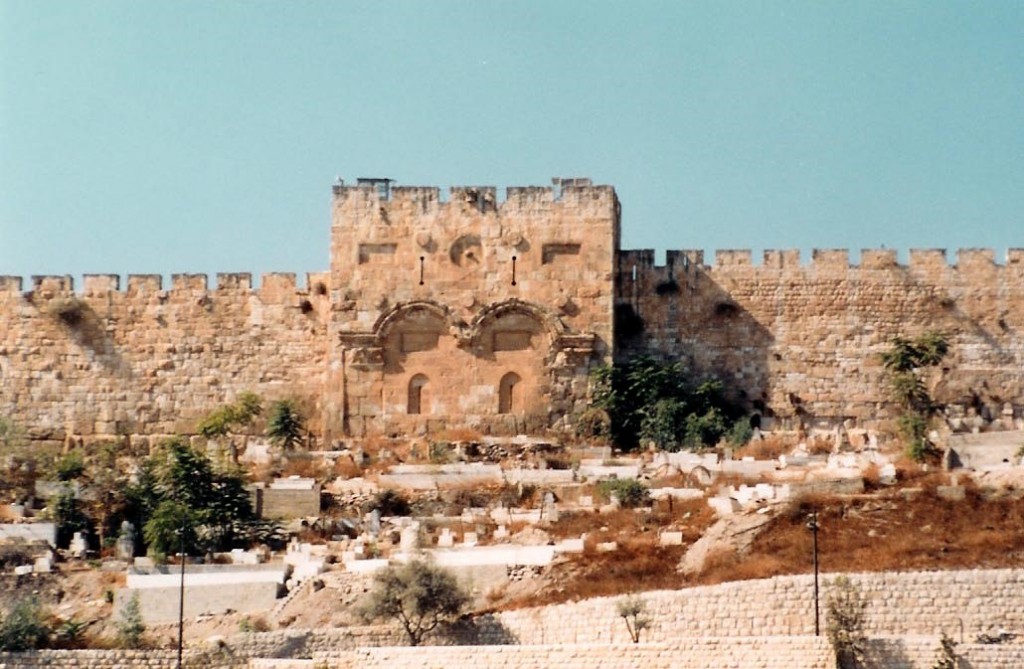
13.01.02.A. THE EASTERN (GOLDEN) GATE OF JERUSALEM. The Eastern Gate seen today was rebuilt by Suleiman the Magnificent in 1538 and stands upon the original gate where Jesus made His triumphal entry. Suleiman, however, eventually learned that Christians believed that their Messiah would one day ride through it. In response, he closed it and placed a cemetery in front of it believing that the Messiah would not defile Himself by going over it.[3] Photograph by the author.
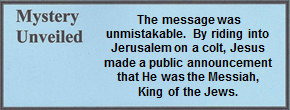
“You will find a young donkey.” Some translations read, “You will find a colt,” with a reference to the young donkey. In this description Mark agrees with Luke; however, Matthew is somewhat more descriptive when he said, “You will find a donkey . . . with her colt by her.” John simply stated that Jesus “found a young donkey and sat upon it.” The fact that three gospel writers did not mention the young offspring is not an error; not all writers elected to include that detail. What is important is that this was a young donkey, and most certainly, she had her first colt. The young donkey also would have been called a colt.
The statement, “You will find a young donkey,” is a classic example of an angaria – the custom of a temporary procurement of resources for the benefit of a leader, ruler, or rabbi.[4] That is why Jesus said, “The Lord needs it.” That statement let the owner know his donkey was not being stolen, but it was the custom of angaria. This custom is unknown in Western culture today. But Jesus needed a donkey for symbolic reasons as this imagery connected Him with Hebrew prophecies. While during the Inter-Testamental period and at the time of Jesus, kings rode horses, centuries earlier in Jewish history, they rode donkeys.[5] The horse was symbolic of war, whereas the donkey was symbolic of peace – two images that were well established in biblical times. Note the following examples:
Prophetic Scriptures such as Genesis 49:10, Isaiah 62:11, and Zechariah 9:9 portrayed a vivid image of a messianic king riding into Jerusalem on a donkey, not a horse. Therefore, Jesus fulfilled the image the rabbis told people concerning the messianic miracles and other prophecies in their Hebrew Bible. He could not have ridden a horse, as that would have been symbolic of a military victor.[6] Jesus never endorsed, nor opposed, the nationalistic fever by word or by deed. The donkey was a symbol of peace and servanthood.[7] Men do not fear those whose mission is peace, but they fear men of war. At issue here was the conflict between belief and unbelief, light and darkness, death and resurrection into new life. If there was ever a symbol to show that Jesus was not going to overthrow the Romans, the donkey was that symbol. Yet the thousands of people cheering and welcoming Him into the city were worrisome for Jewish leaders. Ironically, there is no record that the Romans were concerned although they were always on full alert.
13.01.02.Q1 Why did Jesus need to ride a donkey that was not trained to accept a rider (Mt. 21:4-7; Mk. 11:4-7; Lk. 19:29-31; Jn. 12:14-16)?
To have ridden a trained beast of burden would have meant that Jesus was on a “used” or “second hand” animal. It is a fundamental rule of worship that all that is ever given or used to honor God is to be pure and holy, never having been used for anything else previously. Animals used for religious service, likewise, had to be pure, holy, and never used previously.[8] Therefore, Jesus had to ride a colt that was never ridden. Another example of this purity law is the brand new tomb in which Jesus was laid – it had not even become anyone’s family tomb.
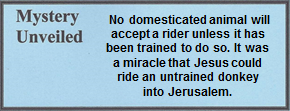
The phrase, “on which no one has ever sat” is significant for another reason: To sit on a donkey is to ride it, and this was another miracle as Jesus demonstrated He had power and dominion over nature. Anyone who mounts a donkey, horse, or any other animal for the first time will be thrown off because all domesticated animals need to be trained to accept a rider. For an untrained donkey to accept a rider, especially when she had her young foal, was definitely miraculous. What Jesus did was clearly against all laws of nature.
13.01.02.Q2 How is the apparent conflict of the number of donkeys explained (Mt. 21:4-7; Mk. 11:4-7; Lk. 19:29-31; Jn. 12:14-16)?
Matthew, who wrote to a Jewish audience, made it a point to report that when Jesus rode a donkey into Jerusalem He was fulfilling the prophecy of Zechariah 9:9. He also said that Jesus told His disciples to bring them (Mt. 21:2) and restated the plurality in the following verse when He said our Lord needs them, obviously meaning both the donkey and her colt.[9] Matthew perhaps recorded the presence of the colt, as it was too young to be taken from the mother. This would emphasize the uniqueness of Jesus riding upon it. Mark and Luke reported only one donkey, which was the focus of each writer.
In this scene, the issue of “Was it one or two?” reappears. In another passage is the issue of whether there were one or two blind men by Jericho, one or two Jerichos (12.04.05.Q1), or one or two demoniacs on the eastern shore by Gadara (08.06.03.Q4). If there were two, then obviously there had to be one. But if the focus of discussion is on one, then the second person, place, or thing is out of the discussion – mentioned only that it existed.
The imagery of a donkey continued to be a challenge for the Jewish people. A passage in the Talmud recorded similar imagery with an interesting prophetic twist of the messiah riding a white horse. Note the phrase “if they are meritorious” (below) reflects the common thinking of the day that the messiah will come only after the Jews cleanse themselves and live pure and holy lives. Jesus came because it is impossible for humanity to present itself pure and holy before God; hence, He paid the price of sin with His life.
It is written, “Behold your king comes to you, lowly and riding on a donkey” (Zech. 9:9). If they are meritorious, he will come with the clouds of heaven; if not, lowly and riding upon a donkey. King Shapur[10] said to Samuel, “You maintain that the Messiah will come upon a donkey: I will rather send him a white horse of mine.”
Babylonian Talmud, Sanhedrin 98a
The Talmud reflects the common thinking that the Jewish people wanted a Messiah who would give them political freedom as reflected by the comment of the white horse – a victorious military animal. This opinion continued centuries later when the Talmud was written. In contrast, notice the powerful symbolism of His entry:
It is understandable that the religious leaders were nearly paranoid. No wonder they came to Jesus and asked Him to calm the crowd (Lk. 19:39-40; Jn. 12:19). It was a most unusual request in light of the many times they criticized Him.
While Matthew’s focus was to report the fulfillment of biblical prophecy to a Jewish audience who knew the Old Testament prophecies, Mark and Luke wrote to Gentile audiences who had little or no knowledge of Hebrew prophecies. Therefore, the second and third evangelists would not have reported this information. They did, however, report that the donkey had never been ridden and the animal was completely submissive to Jesus. Everyone understood this was against all laws of nature; clearly a miracle!
“Daughter Zion … your king comes to you.” The phrase “Daughter Zion” or “Daughter of Zion” is a personification of Mount Zion, which was that part of Jerusalem. It represents Jerusalem and all of its inhabitants. However, at times the phrase “daughter” can refer to the villages that surround the Jerusalem such as Bethlehem. In this case, Jesus combined these two phrases from two verses from the Hebrew Bible: Isaiah 62:11 and Zechariah 9:9. Note the following,
11 Look, the LORD has proclaimed
to the ends of the earth,
“Say to Daughter Zion:
Look, your salvation is coming,
His reward is with him,
and His gifts accompany Him.’”
Isaiah 62:11
A unique feature of this passage is Isaiah’s word for salvation. It is Yesha, and is identical to the Hebrew name of Jesus, that is Yeshua, except that the latter has the optional letter vav.[11] Furthermore, the word Yesha does more than imply a person, it implies Deity. Jesus connected portions of Isaiah’s passage with portions of Zechariah 9:9,
9 Rejoice greatly, Daughter Zion!
Shout in triumph, Daughter Jerusalem!
Look, your King is coming to you;
He is righteous and victorious,
humble and riding on a donkey,
on a colt,
the foal of a donkey.
Zechariah 9:9
The implication is that God, the salvation of Israel, and the expected Messiah, are all one embodied in Jesus of Nazareth. By reflecting upon Isaiah and Zechariah, Jesus implies that there is still work ahead of Him, and that is His return.
[1]. Among the Dead Sea Scrolls were found some scrolls known as the Temple Scrolls. The reference to the three villages as leper colonies is found on column 46, lines 16-18.
[2]. Geikie, The Life and Words of Christ. 2:310.
[3]. Packer, Tenney, and White, eds., Nelson’s Illustrated Encyclopedia. 40.
[4]. Bock, Jesus According to Scripture. 313.
[5]. Judg. 10:4; 12:14, 25a; 16:2.
[6]. Johnston, Gordon “Introduction to Hebrew Language Study.” Lecture series at the Lancaster Bible College, Lancaster, PA. Fall, 1997.
[7]. Farrar, Life of Christ. 330-31; Stein, R. Jesus the Messiah. 179.
[8]. Num. 19:2; Deut. 21:3; Isa. 6:7.
[9]. Stern, Jewish New Testament Commenatary. 62.
[10]. A Jewish king outside of Judea who struggled against the Romans.
[11]. Stern, Jewish New Testament Commentary. 61.
13.01.03 Lk. 19:36-40; Mk. 11:8 (See also Mt. 21:8-9) Jerusalem, Sunday
JESUS ENTERS JERUSALEM
Lk. 36 As He was going along, they were spreading their robes on the road. 37 Now He came near the path down the Mount of Olives, and the whole crowd of the disciples began to praise God joyfully with a loud voice for all the miracles they had seen:
38 The King who comes
in the name of the Lord
is the blessed One (Ps. 118:26).
Peace in heaven
and glory in the highest heaven!
39 Some of the Pharisees from the crowd told Him, “Teacher, rebuke Your disciples.”
40 He answered, “I tell you, if they were to keep silent, the stones would cry out!”
Mk. 8 Many people spread their robes on the road, and others spread leafy branches cut from the fields.
“The King who comes in the name of the Lord is the blessed One.” This is an amazing statement with a profound message that is sadly, so often missed in commentaries. The crowds clearly stated that they were accepting Jesus to be their king! It was a royal greeting that is recorded five times in the gospels.[1] It is similar to a typical generic royal greeting that states, “May King [so-and-so] live forever.” What the crowds shouted when Jesus rode into town was more than a royal greeting; they said He came as a representative of the Lord! But that does not mean that they recognized Him as Deity. That would happen later after His resurrection.
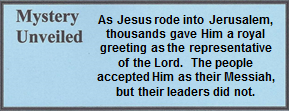
“The stones would cry out.” In this context, if the people would not recognize Jesus as their Messiah, then the rocks would have done so. For centuries the phrase has been considered a figure of speech due to the nature and work of Jesus. The statement echoed the words of the prophet Habakkuk.
For the stones will cry out from the wall,
and the rafters will answer them from the woodwork.
Habakkuk 2:11
However, in the past two centuries there have been two unique phenomena:
“Leafy branches.” In their description of this event, Matthew, Mark, and John each use a different word for branches. Matthew described young shoots, Mark said the people used straw, rushes or leaves that were beaten together, and John mentioned palm branches.[3] There is no disagreement because the people quickly gathered whatever they could to honor Jesus.
[1]. 1 Kgs. 1:39; 2 Kgs. 11:12; 2 Chron. 23:11; 1 Sam. 10:24; 2 Sam. 16:16.
[2]. Archaeology does not “prove” the truthfulness of the Bible. It is a scientific method of research that stresses experimentation and induction from data rather than philosophical deduction in the tradition of Aristotle. When evidence uncovered by archaeologists is interpreted honestly without bias, the conclusions often agree with the chronology of biblical history. Where agreement fails, additional research is required.
[3]. Vincent, Word Studies in the New Testament. 1:214.
13.01.04 Jn. 12:12-13a; Mk. 11:9-10; Jn. 12:13b Jerusalem: The Triumphal Entry
A LARGE CROWD CALLS JESUS “THE KING OF ISRAEL”
Jn. 12 The next day, when the large crowd that had come to the festival heard that Jesus was coming to Jerusalem, 13a they took palm branches and went out to meet Him.
Mk. 9 Then those who went ahead and those who followed kept shouting:
Hosanna!
He who comes in the name
of the Lord is the blessed One!
10 The coming kingdom
of our father David is blessed!
Hosanna in the highest heaven! (Ps. 118:25-26)
Jn. 13b He who comes in the name of the Lord is the blessed One —the King of Israel!”
Thousands came for the Passover celebration. Josephus recorded that the population of the Holy City increased to between two and three million people.[1] Although recent scholarship has documented that his population estimates are somewhat exaggerated, it is well known that a very “large crowd” packed into Jerusalem each year at this time.[2]
“Palm branches … Hosanna” For centuries palm branches[3] were used in the Feast of Tabernacles, a festival that occurs six months later in the fall of the year. However, the presentation of palm branches was common practice in all ancient Middle Eastern cultures that symbolized,
As Jesus entered the city, the crowd shouted, “Hosanna,” (Gk. hosanna 5614)[4] a Greek praise word derived from the Hebrew Hoshana.[5] It originally loosely meant, Hallelujah, and Sabbath.[6] However, since the Maccabean Rebellion, it had been redefined with a nationalistic meaning: deliver us, save us, and give us our freedom – a distinctive messianic message of political freedom. The religious leaders feared such shouting would bring the Roman guards, so they told Jesus to keep His followers quiet.[7] The people must have anticipated that Jesus would become their king – one who would overthrow the Romans – because they had no other reason to obtain palm branches. The request would not have been made if the people were merely praising God, but their palm branches signified political independence.[8]
In the days preceding a festival, as pilgrims entered the city they sang psalms. One such Psalm, 118, has the word, “hosanna” (118:25-26) that was sung while waving palm branches praising God for victories over their enemies.[9] Ironically, later when Jesus and His disciples closed their Passover service, they would sing this same hosanna psalm. According to Jewish writers, this was sung in the temple at Passover,[10] but sung on the way going to the temple at the feast of Tabernacles.[11]
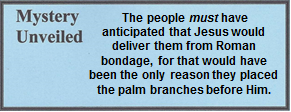
The use of palm branches to welcome a king was a long tradition that reflected nationalistic pride and aspirations.[12] For example, in the Old Testament era, much as today, when a king traveled throughout his kingdom, a herald would first go out and announce the coming of the monarch. The people responded by lining the streets to catch a glimpse of their royalty, whom they perceived to be a god. At the time of his arrival, the king would ride into town on horseback with a procession of military units before and after him. The crowds placed palm branches on the road before him to signify his position as their king. The procession eventually became known as a “parade.”[13] The greeting that Jesus received was identical to what many other men of royalty and high honor received in the ancient Middle East. Note the following examples:
Each man quickly took his garment and put it under Jehu on the bare steps. They blew the ram’s horn and proclaimed, “Jehu is king!”
2 Kings 9:13
This same account was paraphrased by Josephus, who said,
…And when they were eager about the matter, and desired he (Elisha) would tell them, he answered that God had said he had chosen him (Jehu) to be king over the multitude. When he had said this, every one of them put off his garment and strewed it under him, and blew with trumpets, and gave notice that Jehu was king.
Josephus, Antiquities 9.6.2 (111)
In the month of Arahshamnu, the third day, Cyrus entered Babylon, green twigs were spread before him (and) the state of Peace (sulmu) was imposed upon the city. Cyrus sent greetings to all Babylon.
Cyrus II Tablet [17]
They celebrated it for eight days with rejoicing . . . Therefore, carrying ivy-wreathed wands and beautiful branches and also fronds of palm, they offered hymns of thanksgiving to him who had given success to the purifying of his own holy place.
2 Maccabees 10:6a, 7[19]
With thanksgiving, and branches of palm trees, and with harps, and cymbals, and with viols,[20] and hymns, and songs, because a great enemy was destroyed out of Israel.
2 Maccabees 13:51
After the successful Maccabean Revolt, Israel enjoyed a century of political independence but it was full of political corruption and strife. During this time, Alexander Jannaeus (d. 78 B.C.) minted coins that featured the palm branch and the words, “Yehonatan the king.” The palm branch was associated with kingship.[21]
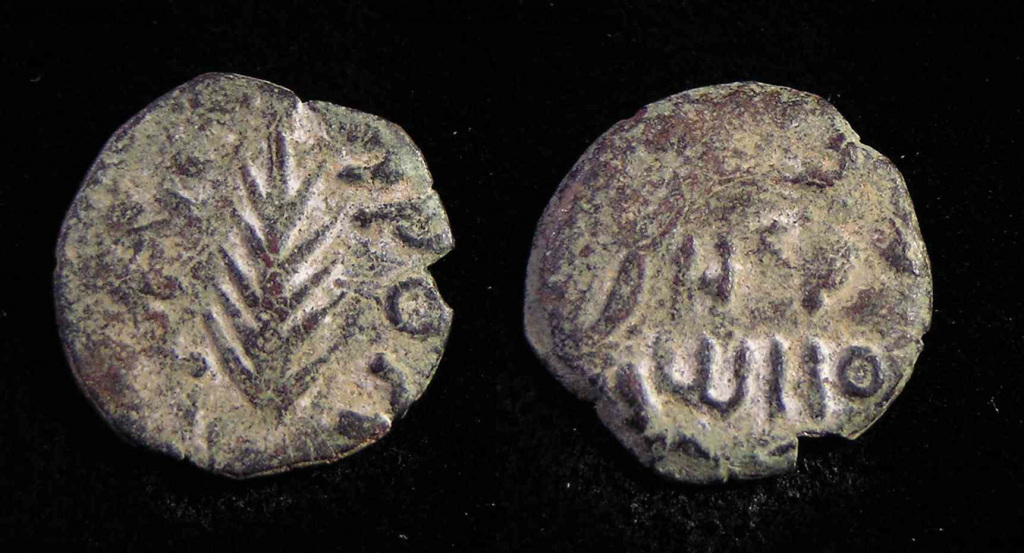 13.01.04.A. COIN BY FESTUS WITH PALM BRANCH. A Jewish coin with palm branch struck by Porcius Festus in A.D. 60 under the reign of Nero. LEFT: The obverse (front) depicts a palm branch. RIGHT: The reverse scene has the legend and a wreath.
13.01.04.A. COIN BY FESTUS WITH PALM BRANCH. A Jewish coin with palm branch struck by Porcius Festus in A.D. 60 under the reign of Nero. LEFT: The obverse (front) depicts a palm branch. RIGHT: The reverse scene has the legend and a wreath.
Finally, eschatologically, the palm branch has a future function when a great multitude, one that will be too massive to count, will wave palm branches before Jesus in heaven. They will shout, “Salvation belongs to our God” (Rev. 7:9-10). To the first century Jews, the palm branch was not a mystery; it was the symbol of victory. Therefore, the obvious question is, why didn’t the Romans and Herodian Dynasty see Jesus as a threat? The answer is that they observed Him for more than three years, during which time He never spoke of violence nor did He speak against the dominating Roman occupation. Would they have seen Jesus as potential threat, He would never have had the opportunity to ride into Jerusalem.

“He who comes in the name of the Lord is the blessed One!” The rabbis taught that this phrase was the Messianic greeting; part of the official greeting all people would give the Messiah when He comes. It is based on Psalm 118:22-27.[22] Now they were witnessing the people greeting Jesus with it. Undoubtedly, this struck terror in the hearts of the religious leaders, especially when they called Jesus “the king of Israel.”[23] This title again demonstrates that the people firmly believed that Jesus would deliver them from Roman oppression. Incidentally, some scholars believe that the phrase, “blessed is he who comes in the name of the Lord.” will be repeated at the return of the Messiah. The term blessed in Hebrew is baruk and in Greek is makarious. The word means to praise God with a sense of happiness and joy upon man.[24] More specifically, it refers to a quality of spirituality that is already present.[25]
Ironically, the day the crowds waived palm branches before Jesus was the same day – the Sunday before Passover – they selected their sacrificial lambs. The head of every family entered the city and purchased the lamb that was to be sacrificed on the following Friday at Passover. This was the same day that Jesus entered the city because He was the Lamb chosen of God. The popularity that was in His favor would never be lost by the common people. Yet while the religious leaders were preparing to sacrifice thousands of lambs for the people, they were also planning to kill the Lamb of God.
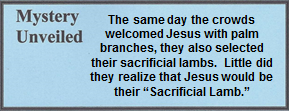
When examining the life and ministry of Jesus and how the religious leaders responded, the development of their negative attitude can be traced as follows:
Previously, the Jewish leadership had many reasons to kill Jesus.[26] Now they had three more.
[1]. Josephus, Wars 6.9.3; 2.14.3.
[2]. Gilbrant, “Mark.” 377.
[3]. Mishnah, Bikkurim 1:3; 1 Macc. 13:51; Jn. 1:13; Palm trees grew in Jerusalem as ornamental trees, since they do not bear edible fruit at that altitude (about 2600 ft. above sea level) and in that climate See also Kloner and Zissu. The Necropolis of Jerusalem in the Second Temple Period. 35.
[4]. Vine, “Hosanna.” Vine’s Complete Expository Dictionary. 2:312.
[5]. Fruchtenbaum, The Jewish Foundation of the Life of Messiah: Instructor’s Manual. Class 19, page 13.
[6]. Major, Manson, and Wright, The Mission and Message of Jesus. 856.
[7]. See comments on Mt. 8:1-4 and the Psalms of Solomon.
[8]. Stein, R. Jesus the Messiah. 181.
[9]. Stein, R. Jesus the Messiah. 180-82.
[10]. Mishnah, Pesahim 5:7.
[11]. Mishnah, Sukkah 4:5.
[12]. Kinman. “Jesus’ Royal Entry into Jerusalem.” 405.
[13]. Lecture by Marc Turnage. “Jesus and His Times.” Teacher Assistant to R. Steven Notley. Jerusalem University College, Israel: June-July, 1999.
[14]. Targam, Esther 10.15. Cited by Geikie, The Life and Words of Christ. 2:396.
[15]. Herodous, Histories 7.54. Cited by Geikie, The Life and Words of Christ. 2:396.
[16]. The grandson of Cyrus I.
[17]. Prichard, The Ancient Near East. 1:204.
[18]. Hellerman, “Purity and Nationalism in Second Temple Literature: 1-2 Maccabees and Jubilees.” 407.
[19]. First and 2nd Maccabees belong to a classification of extra-biblical books known as the Apocrypha. These two literary works are deemed highly reliable historically. See 02.02.03 “Apocrypha” for more information.
[20]. The identity of the musical instruments referred to as “viols” is uncertain, since the viol was developed in Italy around 1510 and the violin about twenty years later. Source: http://www.diabolus.org/guide/viols.htm. Retrieved August 3, 2013. However, another website, http://www.atelierdes7cordes.com/profile%20gb.html.shows bas-relief images showing musicians playing stringed instruments have been dated to 2500 B.C. Retrieved August 3, 2013.
[21]. Hendin, Guide to Biblical Coins. 43, no. 8; For additional study, see Frederick W. Madden. Coins of the Jews. Boston: James Osgood, 1881.
[22]. Fruchtenbaum, The Jewish Foundation of the Life of Messiah: Instructor’s Manual. Class 19, page 14.
[23]. Pentecost, The Words and Works of Jesus Christ. 373.
[24]. Weasel, “Blessed.” 1:201; Becker, “Blessing, Blessed, Happy.” 1:206-08.
[25]. Bailey, Jesus through Middle Eastern Eyes. 66-68.
[26]. See 12.04.08.
13.01.05 Lk. 19:41-44
JESUS SEES THE COMING DESTRUCTION
41 As He approached and saw the city, He wept over it, 42 saying, “If you knew this day what would bring peace — but now it is hidden from your eyes. 43 For the days will come on you when your enemies will build an embankment against you, surround you, and hem you in on every side. 44 They will crush you and your children within you to the ground, and they will not leave one stone on another in you, because you did not recognize the time of your visitation.”
“If you knew this day what would bring peace.” There are few verses more stunning than this one. This was the official presentation of Jesus to the nation of Israel as their Messiah, as the Prince of Peace, and as the Lamb of God. His statement and His entry are a fulfillment of the prophetic words of the Prophet Daniel.[1] The phrase “this day” is a reference to the day Jesus enter Jerusalem and fulfilled the prophecy of Psalm 118,[2]
This is the day the Lord has made;
let us rejoice and be glad in it.
Psalm 118:24
The day that the messiah would ride into Jerusalem finally arrived. The next verse (25a) reads, “Lord, save us!” which is precisely why the people shouted “Hosanna” (Lk. 19:42), which means Lord, save us. The crowds knew that they were shouting a reference to Psalms when they addressed this phrase to Jesus – for they wanted Him to be their king; their messiah. Unfortunately, national Israel would reject Jesus, which is why Jesus later said in Luke 19:42 that if they “knew this day” would bring them peace – the phrase is a reference to Psalm 118:24.
Again, the humanity of Jesus is heavy as He wept. In this phrase the word for wept means to cry loudly. He looked into the future and could see the coming destruction of the temple, the dispersion of His people, and the rejection of His love. He wept because His people were still looking for a political leader to bring peace that only He could provide; the leadership preferred their socially popular aristocratic and prosperous life rather than a holy life committed to God.
“For the days will come on you.” Some translations read “the days are coming,” which is judgment terminology – a prediction based upon similar statements in the Old Testament that divine judgment is at hand.[3] The destruction that Jesus foresaw was one of horrific carnage. As His followers saw the prophecies come into fulfillment, they followed His advice and escaped. History recorded the 9 steps to Jerusalem’s destruction:
So now Titus’s banks were advanced a great way, notwithstanding his soldiers had been very much distressed from the wall. He then sent a part of horsemen and ordered they should lay ambushes for those that went out into the valleys to gather food.
Josephus, Wars 5.11.1 (446)
Now the length of this wall was forty furlongs, one only abated. Now this wall without were erected thirteen places to keep garrisons in, the circumference of which, put together, amounted to ten furlongs, the whole was completed in three days; so that what would naturally have required some months, was done in so short an interval as is incredible. When Titus had therefore encompassed the city with this wall and put garrisons into proper places, he went around the wall, at the first watch of the night, and observed how the guard was kept; the second watch he allotted to Alexander, the commanders of legions took the third watch.
Josephus, Wars 5.12.2 (508-510)
Now, so soon the army had no more people to slay or to plunder, because there remained none to be the subjects of their fury (for they would not have spared any, had there remained any other such work to be done) Caesar gave orders that they should now demolish the entire city and temple, but should leave as many of the towers standing as were of the greatest eminency; that is [the towers of] Phasaelus, and Hippicus, and Mariamne, and so much of the wall as enclosed the city on the west side. This wall was spared in order to afford a camp for such as were to lie in garrison; as were the towers also spared, in order to demonstrate to posterity what kind of city it was and how well fortified, which the Roman valor had subdued; but for the rest of the wall, it was so thoroughly laid even with the ground by those that dug it up to the foundation, that there was left nothing to make those that came thither believe it had ever been inhabited. This was the end which Jerusalem came to by the madness of those that were for innovations; a city otherwise of great magnificence, and of mighty fame among all mankind.
Josephus, Wars 7.1.1 (1-4)
Luke said this coming destruction (21:22) would be the “time of punishment,” prophesied because of the unfaithfulness of God’s people.[9] That may be why the temple doors mysteriously opened for the Romans to enter, as reported by the historian:
The security of their holy house was dissolved of its own accord, and that the gate opened for the advantage of their enemies.
Josephus, Wars 6.5.3 (296)
Concerning Jerusalem, Josephus further wrote that the pain and suffering they endured was the worst they ever experienced in their history. Those who attempted an escape were caught and crucified a short distance outside the city walls for all inside to see. With the decline of moral and religious values, God’s chosen people acted worse than animals. One account is of a woman who cooked and ate her own son in an attempt to survive the starvation. The news of the event horrified everybody, and the survivors deemed those who had already died as “happy.”[10]
Nor would men believe that those who were dying had no food; but the robbers would search. Now of those who perished by famine in the city, the number was prodigious, and the miseries they underwent were unspeakable; for if so much as a shadow of any food did appear, a war was commenced presently; and the dearest friends fell a fighting one with another about it, snatching from each other the most miserable supports of life. Nor would men believe that those who were dying had no food, but robbers would search them when they were expiring, lest any should have any concealed food in their bosoms, and counterfeited dying.
Josephus, Wars 6.3.3 (193-195)
Josephus, who was an eyewitness to the destruction, was so moved by what he saw, that he recorded his personal opinions, something which he seldom did.
But why do I describe the shameless impudence that the famine brought on men in eating their inanimate things, while I am going to relate a matter of fact, the things to which no history relates, either among the Greeks or Barbarians! It is horrible to speak of, and incredible when heard.
Josephus, Wars 6.3.3 (199)
The madness of the seditious did also increase together with their famine, and both miseries were every day inflamed more and more; for there was no corn (grain) which appeared anywhere publicly, but the robbers came running into, and searching men’s private houses; and then, if they found any, they tormented them because they had denied they had any. And if they found none, they tormented them worse because they supposed they had more carefully concealed it. The indication they made use of whether they had any or not, was taken from the bodies of these miserable wretches; which, if they were in good case, they supposed they were in no want at all of food. But if they wasted away they walked off without searching any farther; nor did they think it proper to kill such as these because they would very soon die for want of food.
Josephus, Wars 5.10.2 (424b-426a)
It was now a miserable case and a sight that would bring tears to our eyes, how men stood as to their food, while the more powerful had more than enough and the weaker were lamenting (for the want of it). But the famine was too hard for other passions, and it is destructive to nothing so much as to modesty; for what was otherwise worthy of reverence was in this case despised insomuch that children pulled out the very morsels that their fathers were eating out of their very mouths, and, what was still more to be pitied, so did the mothers do as to their infants; and when those that were most dear were perishing under their hands, they were not ashamed to take from them the very last drops that might preserve their lives.
Josephus, Wars 5.10.3 (429-430)
The events that occurred in Jerusalem were so horrific that the Jews were forced, by the severity of the famine, to eat their own children. This kind of cannibalistic action was completely unknown even by the pagan Greeks and Barbarians. Yet the historian’s account records the fulfillment of the prophetic words of Moses.
You will eat the flesh of your sons;
You will eat the flesh of your daughters.
Leviticus 26:29
The historian continues his lengthy account of the destruction of Jerusalem and the famine that accompanied it. He presented the account of a certain wealthy woman named Mary, who had moved into the city with her son. She, too, was among the famine victims who became unusually desperate. Of her Josephus wrote:
She then attempted a most unnatural thing; and snatching up her son, who was a child sucking at her breast, she said, “O you miserable infant! For whom shall I preserve you in this war with the Romans, if they preserve our lives we will be slaves! This famine also will destroy us, even before that slavery comes upon us: – yet are these seditious rogues more terrible than both the other. Come on; be my food, and be a fury to these seditious varlets and a byword to the world, which is all that is now wanting to complete the calamities of us Jews.”
As soon as she said this she slew her son; and then roasted him, and ate half of him, and kept the other half by her concealed. Upon the seditious came in presently and smelling the horrid scent of this food, they threatened her that they would cut her throat immediately if she did not show them what food she had gotten ready. She replied that she had saved a very fine portion of it for them; and withal uncovered what was left of her son. Thereupon they were seized with a horror and amazement of mind, and stood astonished at the sight; when she said to them, “This is my own son and what was done was my own doing! Come, eat of this food; for I have eaten of it myself! Do not you pretend to be either more tender than a woman or more compassionate than a mother; but if you be so scrupulous and do abominate this my sacrifice, as I have eaten the one half let the rest be reserved for me also.”
After which those men went out trembling being never so much affrighted at anything as they were at this, and with some difficulty they left the rest of that meat to the mother. Upon which the whole city was full of this horrid action immediately; and while everybody laid his miserable case before their own eyes, they trembled as if this unheard of action had been by themselves. So those that were thus distressed by the famine were very desirous to die and those already dead were esteemed happy, because they had not lived long enough either to hear or see such miseries.
Josephus, Wars 6.3.4 (208-213)
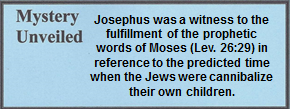
Various attempts to escape were made by the desperate defenders. One such individual was a freedom fighter, Simon, who thought he could escape capture by merely acting like the messiah. The prolific Josephus recorded an interesting account of Simon, who after the destruction of the temple, but still during the siege against Jerusalem, realized he and his men were going to be destroyed. Simon, therefore, took several men, and entered the tunnels below the temple in an attempt to escape. They dug for a while before they realized their plight was hopeless and their provisions were nearly exhausted. Simon then decided he would escape by dressing like the messiah and magically appearing before the people. The story:
And now Simon, thinking that he might be able to astonish and delude the Romans, put on a white frock, and buttoned upon him a purple cloak, appeared out of the ground in the place the temple had formerly been. At the first, indeed, those that saw him were greatly astonished, and stood still where they were; but afterward came near to him, and asked him who he was, but bade them call their captain; and when they ran to tell him, Terentius Rufus, who was left to command the army there, came to Simon, and learned the whole truth, and put him in bonds, and let Caesar know that he was taken. Thus did God bring this man to be punished for what bitter and savage tyranny he had exercised against his countrymen.
Josephus, Wars 7.2.1 (29-31)
And where is not that great city, the metropolis of the Jewish nation, which was fortified by so many walls around it, which could hardly contain the instruments prepared for the war, and which had so many ten thousands of men to fight for it? Where is the city that was believed to have God himself inhabiting therein? It is now demolished to the very foundations; and has nothing but that monument of it preserved, I mean the camp of those that has destroyed it, which still dwells upon its ruins, some unfortunate old men also lie upon the ashes of the temple, and a few women are there preserved alive by the enemy, for our bitter shame and reproach.
Josephus, Wars 7.8.7 (377)
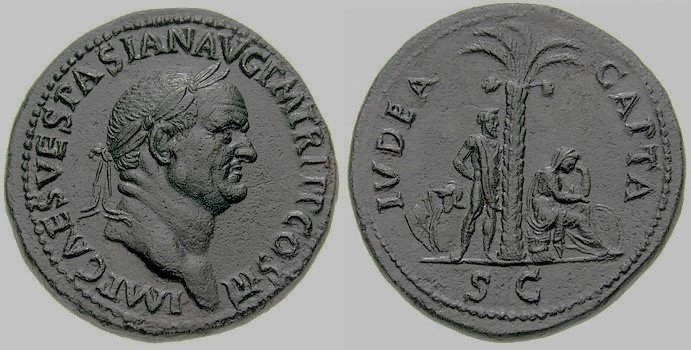
13.01.05.A JUDAEA CAPTA COIN. This coin was minted by the Romans in honor of the conquest over the Jewish people in A.D. 70. No other victory was commemorated by such a large number of coins as the crushing of this revolt. The front honors Emperor Vespasian and the reverse side (right) shows the woman (symbolic of Judea) in a captive position and a man with his hands tied behind his back. SOURCE: Wikipedia Commons.
When the events of the destruction of Jerusalem are compared to the actions of Pilate, it is obvious that his response to Jesus was incredibly compassionate. Jerusalem was in ruins and the Roman army went to the Dead Sea to destroy Qumran and Masada. Soon the Jewish believers, who had previously fled to Pella, returned, and the Holy City was rebuilt.[12]
Unfortunately, within six decades after the temple was destroyed, another messianic pretender, Simon bar Kokhba, arose. He was determined to give the Jews the national freedom they longed for. In the early days of the Bar Kokhba Revolt (A.D. 132-135), many believed that he was their messiah. He minted coins that declared freedom from Roman domination.
Prior to the destruction of Jerusalem, there is no significant extra-biblical literature concerning tension between Jewish believers and the Synagogue. However, tensions increased dramatically after the destruction because Jewish believers had escaped the Roman slaughter and were considered to be cowards by those Jews who remained and suffered. But by the beginning of the Bar Kokhba War in the 130s,[13] there was a complete separation between Jewish believers and traditional Jews.[14] In fact, Eusebius wrote that Bar Kokhba punished believers because they refused to fight against the Romans.[15]
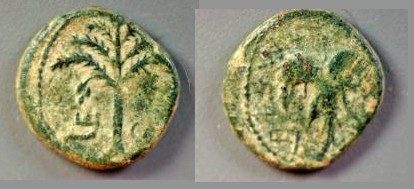
13.01.05.B BAR KOKHBA COIN (A.D. 132) Bar Kokhba Revolt Coin. LEFT: The palm tree represents sovereignity, as it has throughout centuries past. RIGHT: Palm branches and the words “For the Freedom of Jerusalem.” Wikipedia Commons.
But the Romans responded with might, power, and fury. The revolt was crushed by Emperor Hadrian (A.D. 135) who evicted all Jews from Jerusalem, destroyed all trees and gardens within ten Roman miles (stadia) of the city – probably both for military use and to devastate the Jews. He also renamed the land Philistinia, in honor of the ancient Philistines. This is the origin of the modern term Palestine.
Finally, Jesus clearly told them that they failed to “recognize the time of your visitation.” Had they carefully observed Daniel’s prophecies, they would have known the time of the Messiah’s coming was near. Even the magi, those wise men from the east, knew the time was near. Even if the leading Jews missed the prophecies, the visit of the magi should have given them the proverbial wake-up call. Yet they refused to recognize the obvious signs and related consequences. No wonder Jesus was in such deep sorrow for them.
[1]. For additional information related to Daniel’s prophecy, see Appendix 15 and 16.01.18.Q5.
[2]. Bock, Jesus According to Scripture. 315.
[3]. 1 Sam. 2:31; 2 Kg. 20:17; Jer. 7:32-34; 31:38; Isa. 39:6; Zech. 14:1.
[4]. Josephus, Wars 2.14.8 (306-08); 5.11.1 (449-51).
[5]. Lang, Know the Words of Jesus. 341.
[6]. Fruchtenbaum, The Jewish Foundation of the Life of Messiah: Instructor’s Manual. Class 26, page 14.
[7]. Eusebius, Church History 3.5.3; Epiphanius, Panarion 29.7.7.
[8]. Josephus, Wars 5.7.2.
[9]. Isa. 63:4; Jer. 5:29; Hos. 9:7.
[10]. Josephus, Wars 6.4.4-5.
[11]. A growing number of scholars believe this date was the date of destruction for Solomon’s temple, and it became the date to observe other horrific events in Jewish history such as the destruction of the second temple and when the spies returned from Canaan and rejected the land promised by God. Fischer, The Gospels in Their Jewish Context. (Lecture on CD/MP3). Week 10, Session 2.
[12]. Tongue, “Decapolis.” 1:379.
[13]. For further study, see Yigael Yigael, Bar-Kokhba. New York: Random House. 1971.
[14]. Cited by Flusser, “The Jewish-Christian Schism (Part II).” 32.
[15]. Flusser, “The Jewish-Christian Schism (Part II).” 30-31.
13.01.06 Mt. 21:10-11; Jn. 12:17-19
THE PHARISEES RECOGNIZE THE POPULARITY OF JESUS
Mt. 10 When He entered Jerusalem, the whole city was shaken, saying, “Who is this?”
11 And the crowds kept saying, “This is the prophet Jesus from Nazareth in Galilee!”
Jn. 17 Meanwhile, the crowd, which had been with Him when He called Lazarus out of the tomb and raised him from the dead, continued to testify. 18 This is also why the crowd met Him, because they heard He had done this sign.
19 Then the Pharisees said to one another, “You see? You’ve accomplished nothing. Look — the world has gone after Him!”
The people were in a fever pitch, awaiting the son of David, the Messiah. The Pharisees looked at each other and said, “Look — the world has gone after Him!” They realized they were in a losing battle with Jesus and needed to take matters into their own hands, even if it meant breaking conventional laws of justice.
13.01.07 Mk. 11:11 (See also Mt. 21:17)
JESUS RETURNED TO BETHANY
11 And He went into Jerusalem and into the temple complex. After looking around at everything, since it was already late, He went out to Bethany with the Twelve.
Unit 13
The Passion Week Begins
Chapter 02
Prediction Of Israel And Plots Of Jesus’ Death
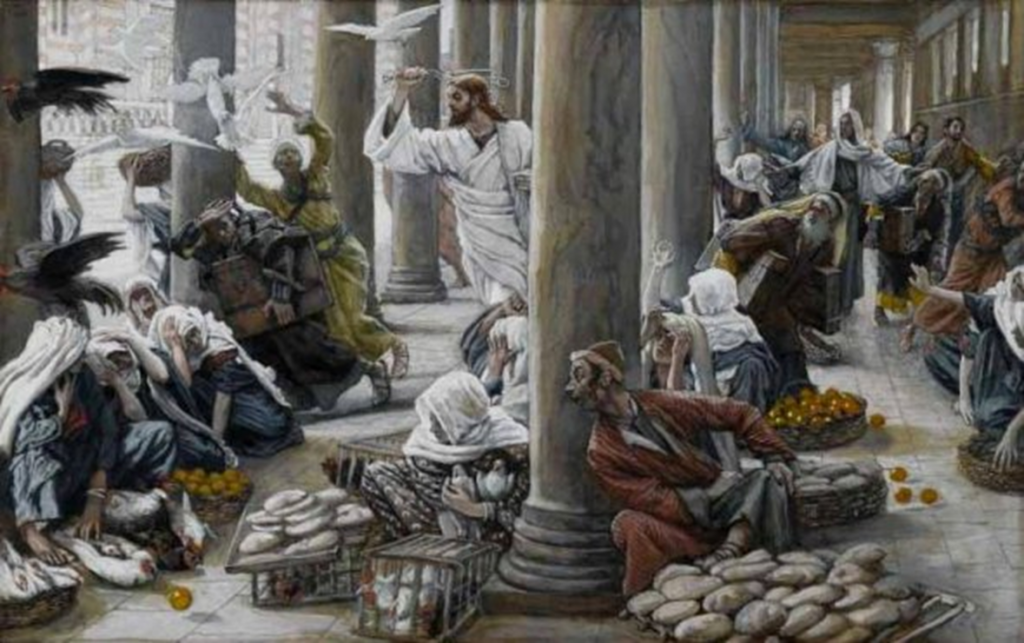 13.02.00.A. MERCHANTS CHASED FROM THE TEMPLE. Illustration by James Tissot. 1884. Jesus began and ended His ministry by cleansing the temple thereby not only emphasizing His displeasure with the religious establishment, but also the importance of holiness before God.
13.02.00.A. MERCHANTS CHASED FROM THE TEMPLE. Illustration by James Tissot. 1884. Jesus began and ended His ministry by cleansing the temple thereby not only emphasizing His displeasure with the religious establishment, but also the importance of holiness before God.